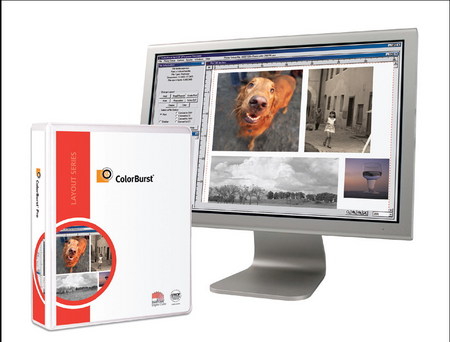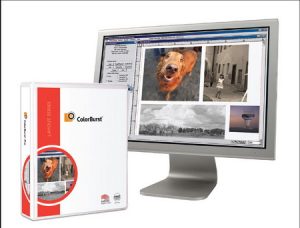A portion of your digital-printing budget will be eaten up by the RIP. Print-production environments require a RIP to maintain color conformity between printers and other devices.
ColorBurst Systems has developed products for the publishing industry since 1980, including OEM RIP versions for grand-format printing.
ColorBurst recognizes the importance of color correctness; all its packages come with SpectralVision Pro, a full-featured, CMYK print profiler (an OEM version of X-Rite-Monaco Gold). With this, users create their own profiles, based on any ink and media combination.
Here, we’ll focus on the ColorBurst Pro software, but we’ll discuss other ColorBurst products too, such as the XPhoto, XProof, PrePress and ProLab.
The ColorBurst Pro®, a PostScript Language (Level Three)-compatible RIP for large-format printing, falls in the company’s “Layout Series” version, which means it handles small, under 17-in., to 110-in.-wide printers. The price ranges from $995 to $3,995, based on the feature set. Specialty products such as ProLab cost $6,995.
Advertisement
System requirements
ColorBurst’s high-end products – Pro, PrePress and ProLab RIP – are Windows®-based. Its lower-end products, XPhoto and XProof, run on either a Windows or Mac platform. The Pro version requires aWindows XP, 2000 or Windows Server 2003 platform.
The program demands at least 512MB RAM, though the system should contain 1GB. The processor should be at least a Pentium 4 CPU, with a speed of at least 1.6GHz and a math co-processor. At least 500MB of free-disk space should be available. Because the software comes on a DVD, you will need a DVD reader.
Finally, you need graphics support for 1,024 x 768 resolution. For our review, we used a system that has 1GB RAM and a Windows 2000 operating system.
Installation
The installation was easy, and the licensed dongle required only one USB port. The software analyzed our system and confirmed our system met or exceeded the minimum system requirements.
Advertisement
The software then installed three applications: the ColorBurst RIP 7.70; SpectralVision Pro, a color-profile-buildingsoftware; and the ColorBurst Expressway, which creates shared Mac and Windows hot folders and printer queues. After the software was installed, we popped in the USB key and fired up the RIP.
Operation
After registration, the main RIP window appears on screen. It’s simple, and comprises two, horizontally placed, main windows. The top window contains a menu bar and a display pane. The bottom window displays messages. A status bar, at the bottom of the screen, gives you a snapshot of the RIP and current printer configuration.
First, tell the RIP which printer you’ll use by choosing Printer Setup from the menu bar. From here, select and load an environment file for your printer, ink and media. (This is like selecting a profile, but much more flexible.)
Select Load, and a file-menu display, which is organized by supported printer manufacturers, appears. ColorBurst supports all the heavy hitters such as Epson, Hewlett-Packard, Roland DGA Corporation, EFI-EFI, etc.
Next, select the printer model or family folder (i.e., the HP 5000 series). Open the appropriate folder, and you’ll see a set of pre-installed environment files that correspond to the printer, media and ink set. The printer environment will now display in the menu bar.
Advertisement
Use the Print Options menu to specify the printer’s specifications. For example, you can set the media size or select the printer’s physical connection, such as parallel, USB or networked. Once a printer is configured, you’re ready to go.
For how-to-print options, use the File Open menu, and select a stan¬dard image type, such as TIFF, JPEG or EPS. When opened, the main window displays a layout that corresponds to the media size. A rectangle with the image name is then displayed. Here, you can continue to add images. The smart nesting function automatically place the images for the best use of the media.
Once in layout, you can edit the images: scale, rotate or crop in place. When you’re satisfied with the layout, click the Print button. The images will be processed (RIPed) and sent to the printer.
The jobs we printed looked absolutely beautiful. The colors were correct, and detail was excellent. We used the pre-loaded environment files and didn’t adjust the images, other than scaling. We can certainly see how a high-pressure shop would benefit from the fast RIP, print speed and ease of preparation.
Advanced features
In many cases, a shop’s team of artists could have a mixture of PCs and Macs. The Pro handles just about everything. You can easily set up as many as 50 queues that correspond to different printer configurations. The queues can then be accessed directly from the design systems. If you use Macs, Expressway Server will load a ColorBurst driver that allows direct printing.
If you create custom, ICC profiles or make more precise color adjustments, you’re in luck. The product comes with SpectralVision Pro, a tool that works with such colorimeters as the X-rite Eye-One. This program generates the proper target prints and keeps track of miss-read blocks. The RIP application profiles every possible color adjustment. Together, you can’t help but get excellent color results.
Conclusion
The ColorBurst RIP family is one of the best we’ve used. The easy installation and setup, and the uncluttered user interface, help get you up and running quickly. Depending on the printer’s size, you can spend as little as $995. We just scratched the surface of this product and didn’t cover many features, such as the nice tiling and step-and-repeat menus. If you’re looking for a RIP, do yourself a favor and check out ColorBurst.
Key Information
ColorBurst Systems, 44710 Cape Court #142, Ashburn, VA 20147, (703) 723-8580, www.colorburstrip.com
Company Profile: Compatible Systems Engineering Inc. (CSE), founded in 1980, is now doing business as ColorBurst Systems. The newly named company develops integrated-publishing systems. Previous releases of ColorBurst include support for the Kodak Approval System and the XEROX electrostatic printer, as well as an OEM version for IRIS printers.
Price: From $695 to $3,995 (specialty products at $6,995)
At a Glance: ColorBurst Pro groups files in a layout with full preview, zoom, crop, scaling and tiling functions. Files can be placed in layout using ColorBurst’s “best-fit” nesting to make the best use of media. AutoSpot™ is built-in for automatically optimized Pantone® colors. SpectralVisionPro, a full-featured CMYK printer profiler, is included to create CMYK ICC printer profies.



 Photo Gallery2 weeks ago
Photo Gallery2 weeks ago
 Paula Fargo2 weeks ago
Paula Fargo2 weeks ago
 Real Deal1 week ago
Real Deal1 week ago
 Photo Gallery2 weeks ago
Photo Gallery2 weeks ago
 Projects1 week ago
Projects1 week ago
 Women in Signs2 weeks ago
Women in Signs2 weeks ago
 Signs of the Times2 weeks ago
Signs of the Times2 weeks ago
 Business Management7 days ago
Business Management7 days ago










